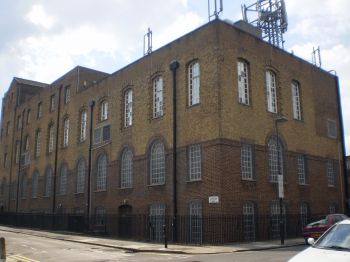Glasite
This article includes a list of references, related reading, or external links, but its sources remain unclear because it lacks inline citations. (April 2009) |
The Glasites were a Christian sect founded in about 1730 in Scotland by John Glas. It was spread by his son-in-law Robert Sandeman into England and America, where they were called Sandemanians.
Glas dissented from the Westminster Confession only in his views as to the spiritual nature of the church and the functions of the civil magistrate. But Sandeman added a distinctive doctrine as to the nature of faith which is thus stated on his tombstone:
- "That the bare death of Jesus Christ without a thought or deed on the part of man, is sufficient to present the chief of sinners spotless before God."
In a series of letters to James Hervey, the author of Theron and Aspasio, Sandeman maintained that justifying faith is a simple assent to the divine testimony concerning Jesus, differing in no way in its character from belief in any ordinary testimony.
Beliefs and practice
In their practice the Glasite churches aimed at a strict conformity with the primitive type of Christianity as understood by them. Each congregation had a plurality of elders, pastors, or bishops, who were chosen according to what were believed to be the instructions of Paul, without regard to previous education or present occupation, and who enjoy a perfect equality in office. To have been married a second time disqualified for ordination, or for continued tenure of the office of bishop.
In all the action of the church unanimity was considered to be necessary; if any member differed in opinion from the rest, he must either surrender his judgment to that of the church, or be shut out from its communion. To join in prayer with any one not a member of the denomination was regarded as unlawful, and even to eat or drink with one who had been excommunicated was held to be wrong. The Lord's Supper was observed weekly; and between forenoon and afternoon service every Sunday a love feast was held at which every member was required to be present. This took the form not of symbolic morsels of wine and bread, as in other communions, but a (relatively) substantial meal, a custom leading to the Glasites' nickname of the 'Kail [ie. cabbage] Kirk'. This custom may have arisen, in part, as a charitable response to the poverty of most members of this Church and also as a pragmatic response to the length of meetings (particularly the sermons) and the distances some members of the congregation had to travel in order to attend.
The gift of speech was allowed to speak. The practice of washing one anothers' feet was at one time observed; and it was for a long time customary for each brother and sister to receive new members, on admission, with a holy kiss.
Things strangled and blood were rigorously abstained from; the lot[citation needed] was regarded as sacred[citation needed]; the accumulation of wealth they held to be unscriptural and improper, and each member considered his property as liable to be called upon at any time to meet the wants of the poor and the necessities of the church.
Churches
Glasite churches were founded in Paisley Glasgow, Edinburgh, Leith, Perth, Dundee, Arbroath, Montrose, Aberdeen, Dunkeld, Cupar, Galashiels. Buildings built as Glasite chapels survive in Dundee, Edinburgh and Perth (two), and possibly elsewhere.


Sandeman moved to London in 1760 with a congregation and established a church at the old Glovers' Hall, Barbicanin 1762. The London church record books show 106 member in 1795 (48 men, 58 women) and 110 members in 1842 (31 men, 58 women). The Sandemanian's relocated to Barnsbury Grove in north London in 1862. Michael Faraday was a Deacon in this London church in the 1830s and an Elder 1840-1844 and again 1860-1864. There is a plaque in the building indicating his seat of prayer. The building is now a telephone exchange and that end of Barnsbury Grove renamed Faraday Close.
Sandeman established fewer than a dozen churches in England including Liverpool before he went to America in 1764. John Howe served as an elder of the Sandemanian church in Halifax, Nova Scotia.
Their exclusiveness in practice, neglect of education for the ministry, and the antinomian tendency of their doctrine contributed to their dissolution. Many Glasites joined the general body of Scottish Congregationalists, and the sect may now be considered extinct.
The last of the Sandemanian churches in America ceased to exist in 1890. The London meeting house finally closed in 1984. The last Elder of the Church died in Edinburgh in 1999.
Critics of Sandemanianism
A prominent critic of Sandemanian beliefs was the Baptist Andrew Fuller (1754-1815) who published Strictures on Sandemanianism (1810) in which he made two telling points. First, if faith concerns the mind only, then there could be no way to distinguish genuine Christians from nominal Christians. Second, knowing Christ is more than mental knowledge of facts about him; it involves a desire for fellowship with him and a delight in his presence.
Sandemanian Families
Prominent Sandemanian familes include the surnames Barnard, Baynes, Baxter, Boosey, Bell, Faraday, Leighton, Mann, Vincent, Whitelaw and Young
Bibliography
- Cantor, Geoffrey: Michael Faraday, Scientist and Sandemanian, Macmillian, 1991
- Smith, John Howard: "The Perfect Rule of the Christian Religion": A History of Sandemanianism in the Eighteenth Century, SUNY Press, 2009
References
This article incorporates text from a publication now in the public domain: Chisholm, Hugh, ed. (1911). Encyclopædia Britannica (11th ed.). Cambridge University Press. {{cite encyclopedia}}: Missing or empty |title= (help)
This article incorporates text from a publication now in the public domain: Wood, James, ed. (1907). The Nuttall Encyclopædia. London and New York: Frederick Warne. {{cite encyclopedia}}: Missing or empty |title= (help)
James Ross, History of Congregational Independency in Scotland (Glasgow, 1900).
